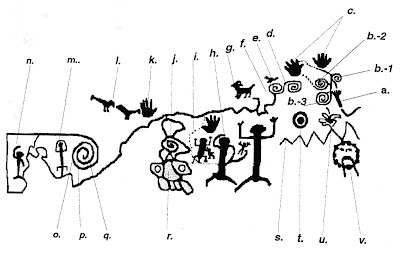www.nmnaturalhistory.org
Saturday, May 7, 2016
GEOLOGY IN ROCK ART - A VOLCANIC ERUPTION AT PETROGLYPH POINT, MESA VERDE? - NOT BY A LONG SHOT:
Petroglyph Point panel, Mesa
Verde, CO. Photograph Peter
Faris, 29 May 1988.
As a return visit to the subject of volcanoes in rock art, I
bring you another one of the fanciful creations by William Eaton (1999). This
is his interpretation of the petroglyph panel at Petroglyph Point in Mesa Verde
as a record of migration by early Puebloan peoples caused by a volcanic
eruption near Grants, New Mexico.
Close up of subject at Petroglyph
Point, Mesa Verde, CO. Photograph
Peter Faris, 29 May 1988.
Eaton's version of the
Petroglyph Point panel,
Fig. 12.5.1, p. 171.
" The subject petroglyph
included a subpanel of five volcanic cones with one in the process of
eruption." (Eaton 1999:170) This statement mystifies me as a simple
viewing of a photograph of the petroglyph panel shows a very different reality.
To begin with Eaton has just omitted many features of the actual panel. The
upper points of the zigzag line that Eaton identifies as five volcanic cones in
actuality show seven points. There are missing images from the left side, from
above the area recorded in his drawing, and almost the one fourth of the panel
on the right side is omitted. Additionally, in the area of the panel he has
illustrated there were many details omitted as well. For instance, there are
only three hand prints in Eaton's diagramming of the panel while I count six in
my photos of the real panel. Also, Eaton's drawing of the jet of molten
lava supposedly spraying out of this volcano has been somewhat altered from the
real petroglyph, and, indeed, the eruption he cited was not one of an explosive volcano
blasting upward. McCartys eruption consisted predominately of a flow of
pahoehoe lava from an 8 meter high cone. Pahoehoe lave is thin and flows
easily, often for long distances. It is not generally produced by an explosive
eruption, but by the liquid running out of a crack in the side of the
volcano.
Mesa Verde was occupied by Ancestral Pueblo peoples from ca.
AD 600 to 1300, approximately seven centuries. Eaton identifies the volcanic
feature that drove his imaginary migration to Mesa Verde as the McCarty's sheet
flow in the Zuni-Bandera Volcanic field. This lava flow occurred 2,500 - 3,900
years ago (1,900 - 500 BC) (geoinfo.nmt.edu). In other words, the lava flow
actually occurred between 3,100 to 4,500
years earlier than the period of full occupation of Mesa Verde.
Eaton's version of the
volcano, Fig. 12.5.1, p. 171.
"A petroglyph panel, some thirty feet in
length, is located in an isolated canyon two miles south of Spruce Tree House
in Mesa Verde National Park, Colorado. This panel, Figure 12.5.1, is unusual
because it offers possible documentary evidence in the form of metaphors of how
(and why) these early Pueblo Indians, migrated to Mesa Verde from their
previous homeland adjacent to the very active volcanic area of El Malpais
National Monument near Grants, New Mexico, circa A. D. 900." (Eaton
1999:179)
"Five volcanic cones in the Malpais area
near Grants, New Mexico, are shown in Figure 12.5.2. Item s represents Cerro
Negro (cone), Valley of the Volcanoes in El Malpais National Monument. The
second cone from the right - item u, McCartys Cone - which erupted circa A.D.
900. It produced lava flows 25 miles long." (Eaton 1999:173)
Lava Fissure in McCartys flow,
www.nmnaturalhistory.org
Early estimates of the age of the eruption of McCartys Cone
were based upon Native American tales and were wildly inaccurate. This appears
to be the date that Eaton has appropriated for his analysis. "Since then, accelerator mass
spectrometer radiocarbon dates of 2970±60 and 3010±70 years B.P. were obtained
on samples of burnt roots." (geoinfo.nmt.edu) These corrected dates for the lava flow were obtained
in 1994. These results show Eaton's
conclusions to be completely impossible. Note, the correct dating had been
published a number of years before Eaton wrote his fictional account, so
either the potential migrants were so scared by the eruption that they waited
paralyzed for 1,600 to 3,000 year before running away, or once again Eaton is
making up his own facts to support his bizarre theories. I am afraid I know
which one I believe.
REFERENCES:
Eaton, William M.
1999 Odyssey of the Pueblo Indians, Turner
Publishing Co., Paducah, KY.
https://geoinfo.nmt.edu/tour/federal/monuments/el_malpais/zuni-bandera/background.html
www.nmnaturalhistory.org
www.nmnaturalhistory.org
Labels:
mesa verde,
petroglyph,
rock art,
volcano Petroglyph Point
Subscribe to:
Post Comments (Atom)









No comments:
Post a Comment